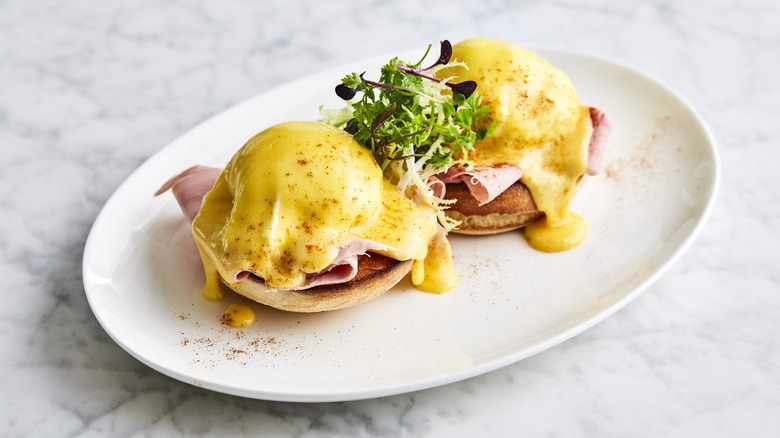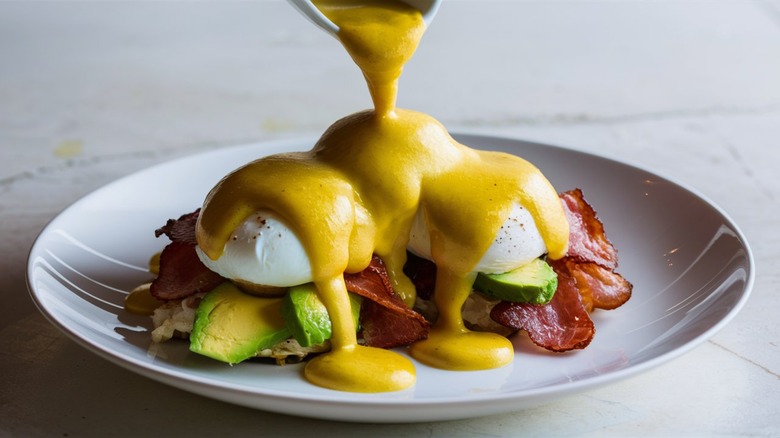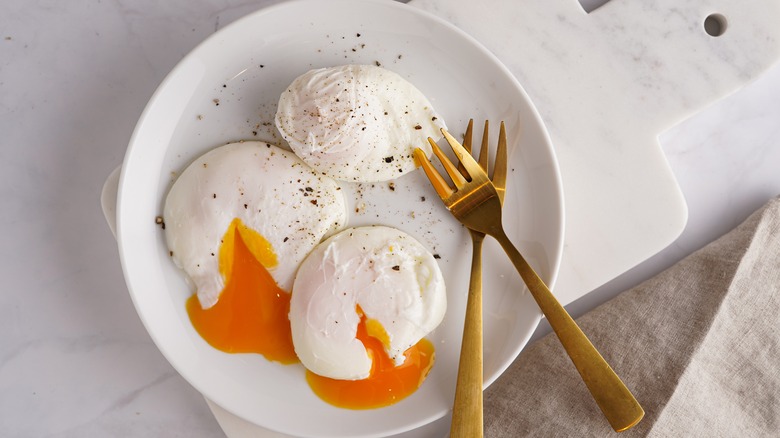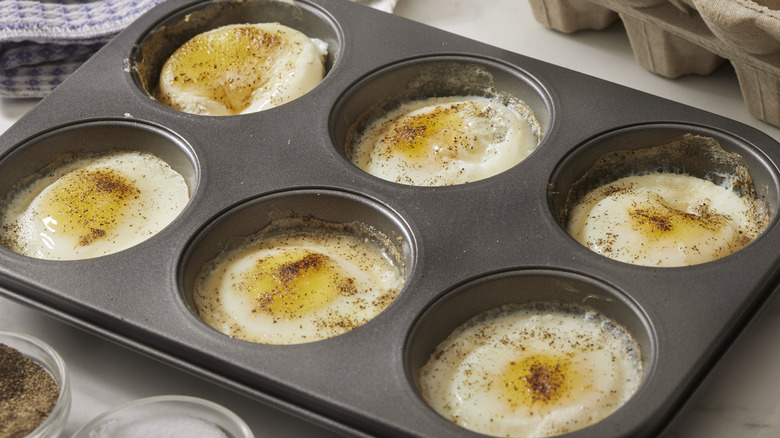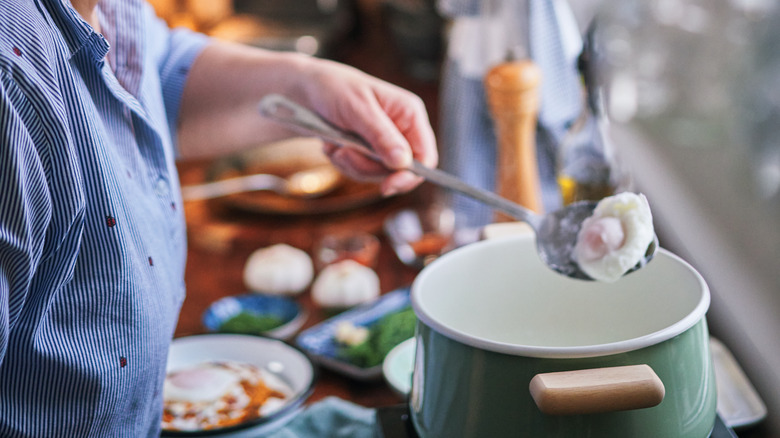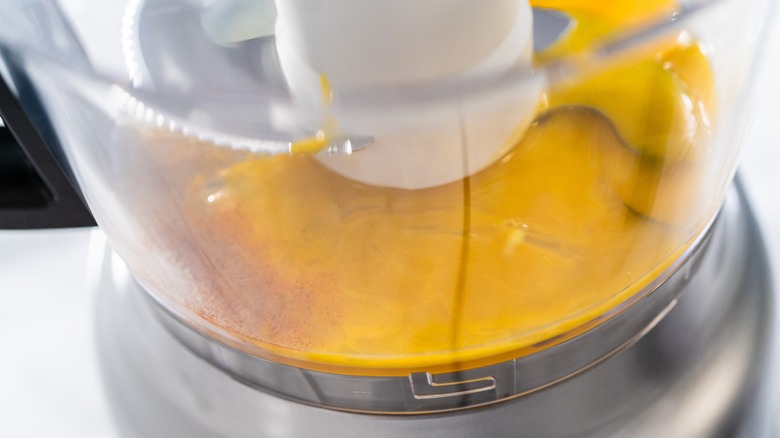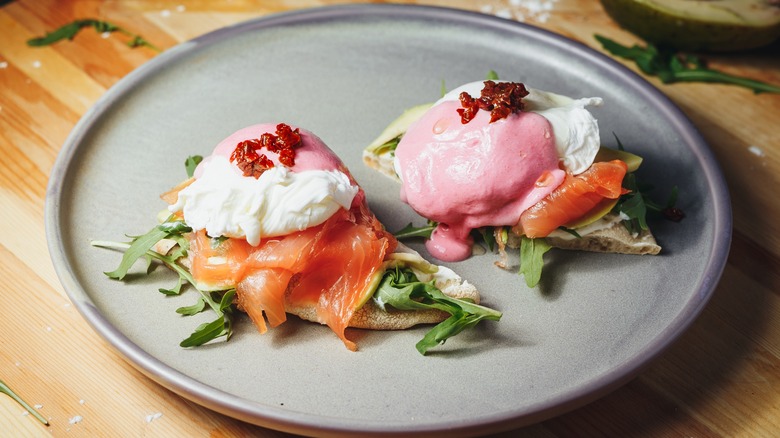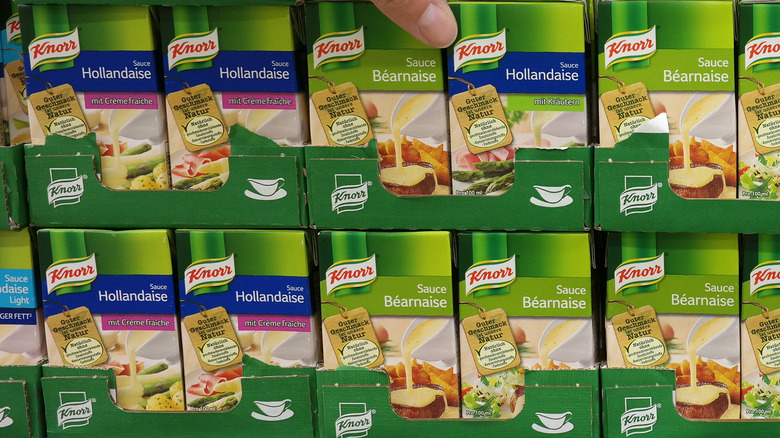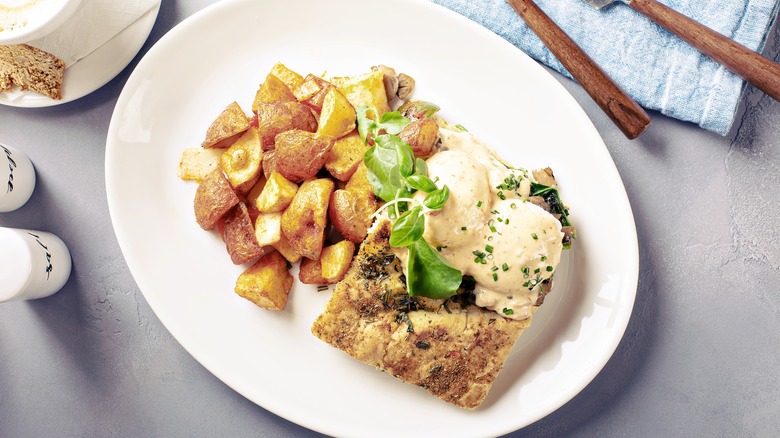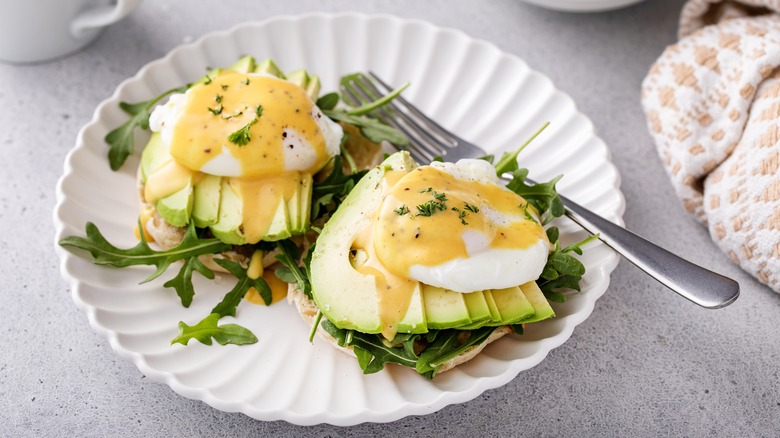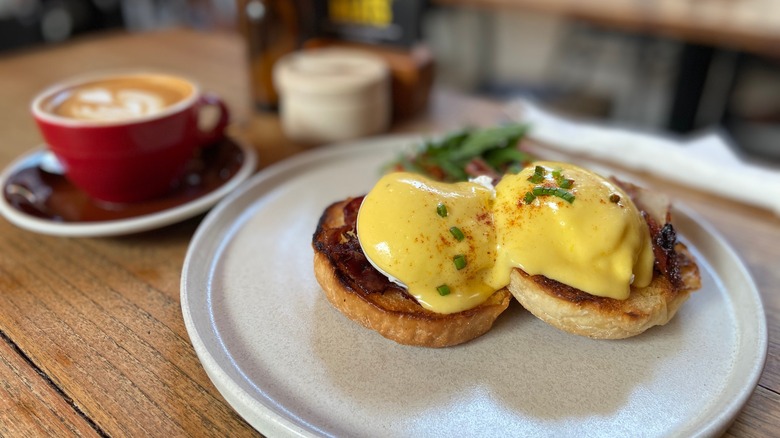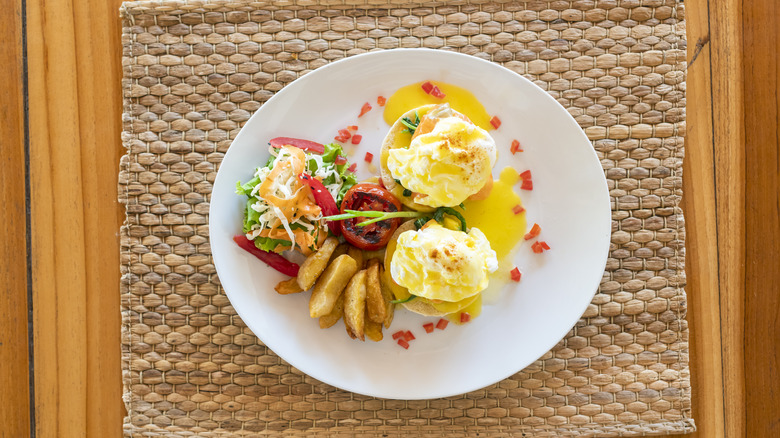A Chef Highlights 13 Big Mistakes To Avoid When Cooking Eggs Benedict
When many of us think of the fanciest gourmet breakfast we could enjoy at a fine dining establishment, eggs Benedict often comes to mind. While the true origins of this elegant dish remain ambiguous at best, its popularity shows no signs of wavering. Indeed, eggs Benedict has even escaped the confines of fancy eateries and made its way into our homes, with egg poaching tools and store-bought hollandaise sauces simplifying the recipe for virtually any cook.
Now, if you've never made a classic eggs Benedict recipe yourself because it seems too daunting to execute, fear not. Though potential pitfalls certainly exist — and can turn this elegant dish into something akin to a failed science experiment in a flash — there are also ways to avoid those mistakes when making eggs Benedict yourself.
In my nearly 18 years as the chef and owner of a foodie-focused bed and breakfast and restaurant, I've made more than my fair share of eggs Benedict dishes. After learning from my own mistakes early on as a chef, I've managed to essentially perfect this recipe — and am prepared to share my wisdom with you. Read on to discover the top mistakes to avoid when cooking eggs Benedict.
1. Mistake: Not preparing ahead
Timing may be the single most important factor to flawlessly executing eggs Benedict (beyond perfecting the individual components). For this reason, advance preparation in the form of a carefully laid out mise en place – which translates to "everything in its place" — is key.
Mise en place involves carefully reviewing a recipe, identifying the ingredients and equipment needed, figuring out how long each step will take, then organizing all of this within your workspace to streamline the cooking process. For the purposes of eggs Benedict, this might include having your poaching liquid ready, the oven preheated, and plateware pre-set and ready-to-serve.
I often poach my eggs first and keep them warm while toasting the English muffins, pan frying Canadian bacon, and whipping up hollandaise sauce. By preparing ahead this way, the delicate hollandaise sauce doesn't have to wait for the other ingredients to be finished before assembling the dish, which can easily make or break any eggs Benedict recipe. These preparation steps may take a bit more effort, but the end result is worth the extra time and care.
2. Mistake: Poaching eggs improperly
For many, the star of eggs Benedict is the poached egg. With a cloud-like exterior encasing a luscious, cheese-like, runny yolk, a poached egg is a glorious thing. When punctured, the yolks delicately blend with the hollandaise sauce, coating the Canadian bacon and English muffins like a vibrant, orange-hued satin sheet. For this reason, it's crucial you know how to poach eggs perfectly before serving them atop eggs Benedict.
There are many common mistakes that you can make when poaching eggs, such as not using the freshest eggs possible to puncturing them while retrieving them from the poaching liquid. Any of these can result in either under or overcooked eggs, which will ultimately ruin the dish.
Remember: you cannot rush this process. It takes time, your full attention, and a little finesse. Plus, learning to poach an egg is a skill that will serve you far beyond eggs Benedict. There's nothing quite like topping a steaming bowl of ramen noodles, fried rice, or your favorite shrimp and grits recipe with a poached egg or two.
3. Mistake: Not considering alternative methods for poaching eggs
There are a number of unconventional ways to poach eggs that work quite well beyond the standard technique. Some of these hacks steam the eggs rather than specifically poaching them, which matters from the perspective of texture (along with the necessity for using oil or cooking spray to lubricate a ramekin or baking cup). That being said, it's helpful to understand the difference between various poaching options, since an alternative cooking method may be worth utilizing.
Two similar alternate poaching methods include utilizing a slow-cooker or employing the handy Instant Pot. Now, the biggest concern with both of these options is that eggs can easily get overcooked. After all, the exact amount of time it will take to poach an egg properly — so the yolk remains runny, but the whites are completely set — tends to vary depending on the appliance. It may take a couple of tries to master these poaching options; once you find the sweet spot, though, be sure to use eggs that are the same size every time.
Another method frequently used by professional kitchens is the cling wrap trick for perfect poached eggs. This hack works well because it contains the egg whites, which are notorious for disintegrating in the liquid and making it look more like an egg drop soup. Additionally, this method enables you to poach many eggs at once without them disrupting one another.
4. Mistake: Only poaching one egg at a time
If you're making eggs Benedict for more than one person (or with more than one egg), it's worth poaching multiple eggs at once. This can be tricky, of course, as egg whites are notoriously delicate and have a tendency to pull apart in the liquid. Adding vinegar helps by denaturing the proteins in the egg whites, forcing their strands to bind together more quickly, but there's still a risk they'll cause the poaching liquid to become murky. Eggs in the same pot may also bump into one another and break or stick together, so consider some options to avoid those mistakes.
As previously noted, one way to poach eggs in bulk is using the cling wrap trick. While this is effective, if you're concerned about the potential safety hazards of this method, there are other options. For example, "Top Chef" winner Mei Lin cures eggs before poaching them. This takes some advance preparation, but soaking the eggs in a vinegar and water blend for 30 minutes before gently simmering helps them hold their shape without turning into a pile of goo.
If you really prefer not to poach multiple eggs simultaneously, you can also cook one egg at a time and keep them warm. The best way to do this (without cooking an egg further) is to transfer it into a bowl of hot water before serving. The water shouldn't be boiling, though — just hot, somewhere around 110 degrees Fahrenheit.
5. Mistake: Failing to season your egg poaching liquid
There's nothing wrong with poaching eggs simply in water with a hint of vinegar or lemon juice. But you're also missing an opportunity to elevate eggs Benedict to new stratospheres by not upgrading your poaching liquid. Indeed, seasoning your poaching liquid is a surefire way of infusing your eggs with flavor, aroma, and even color for a tastier and more visually appealing final product.
Think of the poaching liquid as a blank canvas to add any ingredient you want. Whatever you cook in it will take on those additional flavors, though you'll want to go bold with seasoning if you intend for it to be absorbed by your eggs. One of the most common ways of seasoning poaching liquid is to assemble a bouquet garni, which is a cheesecloth bag filled with various herbs and aromatics, like shallots and citrus rinds.
Another option is to swap out the water with a different poaching liquid altogether. Though you can use stock or broth, don't stop there. Wine, beer, and even milk can give your eggs an intense taste and color that will completely revolutionize your eggs Benedict recipe.
6. Mistake: Making a hollandaise sauce that breaks
Making a classic hollandaise sauce can be an intimidating and frustrating process. Even when you have the technique perfected, hollandaise is notorious for breaking — resulting in something clumpy and unappetizing rather than a rich, velvety sauce. There are a number of hacks for fixing a broken hollandaise sauce, such as adding another egg yolk to the mix. While these are great when needed, they can also markedly impact the flavor and texture of the sauce, so it's best to avoid making a hollandaise that breaks in the first place.
One way to make hollandaise sauce that won't separate quickly is to employ your blender. While the sauce may still end up separating, it's less likely, and this method requires far less elbow grease. Just be sure to purée the sauce long enough to both cook the egg yolks and thicken them. A properly executed sauce will be pale yellow and dense enough to coat a spoon, remember.
Additionally, if you end up with more hollandaise sauce than you can eat, it can be covered and refrigerated for two days. The key is reheating it gently enough so the sauce doesn't separate. The best way to do this is in a glass bowl set over a pot of simmering water. Whisk it a little at a time and remove it from the heat between intervals, until the hollandaise is loose and creamy.
7. Mistake: Not mixing up the flavor of your hollandaise sauce
One mistake to avoid with eggs Benedict is not mixing up the flavors of your hollandaise sauce. While a classic hollandaise is always a fantastic option, tweaking the sauce can also elevate the entire dish. Some of my favorite additions include smoked paprika, spicy chili powder, or a hint of lemony sumac. Just keep in mind: If you're going to add seasoning to your egg poaching liquid, you'll want to select complimentary flavors for the hollandaise sauce, as well.
Another delightful way to add flavor and color to your hollandaise sauce is to jazz it up with red wine. I'd recommend a wine that's not overly oaky or tannic, like a pinot noir or merlot. Be sure to avoid dumping wine straight from the bottle into your sauce, as it can overpower and thin it out. It's also best reduce the wine by half before incorporating it into your hollandaise.
If you'd like a punch of umami-rich flavor, consider adding mushrooms to your hollandaise sauce. When using cooked mushrooms, though, you don't want to purée them into the sauce. This can cause it to become watery and separate, so stir the chopped mushrooms into the finished sauce instead. You can also use pulverized dried mushrooms, which can be added directly to your hollandaise without adversely impacting the texture.
8. Mistake: Only using hollandaise sauce made from scratch
While I'm a hollandaise snob and always make mine from scratch, I understand there are some who'd rather not bother with the hassle of making it (or don't feel comfortable doing so). Fortunately, there are plenty of quality store-bought hollandaise sauces – many of which are perfectly fine to use in a pinch when you have a hankering for eggs Benedict.
Some premium premade hollandaise brands may cost a pretty penny, but others are less expensive — and equally effective at delivering a great sauce. My one recommendation when using a store-bought sauce is to season it a bit further before using it on eggs Benedict. Whether you have a finished sauce or whip one up from a packet, many of these will be a touch salty and lack the nuance you get from a homemade variety.
This is the time to dive into your pantry to add some dried spices or herbs. You can also raid your condiment collection, adding things like a hint of harissa paste or Dijon mustard. Lastly, try tossing in some orange or lime zest for a citrusy tang that will wake up even the sleepiest of taste buds.
9. Mistake: Limiting yourself to Canadian bacon
The standard meat of choice for eggs Benedict is Canadian bacon. While it's unclear precisely why, this round pork product fits perfectly atop an English muffin half, suggesting there may be a connection (though that's just conjecture on my part). Still, there is no reason it should be the only meat you consider for eggs Benedict. There are plenty of other ideal options, including some potentially better pairings for poached eggs and luscious hollandaise sauce.
Perhaps my favorite thing to use instead of Canadian bacon is seafood or fish. Smoked salmon is a delightful, slightly salty, umami-rich substitution, while sweet shellfish, like lobster or shrimp, counterbalance the acidity and richness of the eggs and sauce. I also enjoy making crab cakes from scratch and have made many deluxe eggs Benedicts with them.
If you want to stick with meat, try Andrew Zimmern's take on the classic, which showcases pastrami instead of Canadian bacon. Alternately, if you happen to have leftover corned beef after your St. Patrick's Day celebrations, swap in the leftovers for a slightly salty, zesty alternative to the classic.
10. Mistake: Only using English muffins
There are many reasons why English muffins are the standard for eggs Benedict (and most other breakfast sandwiches for that matter). Their sturdy texture and seemingly infinite nooks and crannies can absorb and withstand the runny egg yolks and rich hollandaise sauce without becoming soggy and falling apart. But there are plenty of other options that can be equally as satisfying and utilitarian, and it's a mistake to avoid other bread options for eggs Benedict recipes.
Other types of bread can suffice, including biscuits, croissants, and even focaccia. Or you can go super snazzy and use French toast or a grilled cheese sammy as the base for your eggs Benedict. If you really want to get international with it, assemble your eggs Benedict atop a quesadilla (you'll thank us later).
Lastly, there's no reason to avoid branching out of the bread kingdom and incorporate other breakfast-loving starches, like the humble potato. Hash browns or roasted potatoes would certainly make for a delightful base, but I'm thinking more along the lines of a Canadian mash-up with french fries. Serve your eggs Benedict poutine-style, by topping french fries with your meat of choice, poached eggs, and hollandaise for a spin on this classic.
11. Mistake: Not adding other ingredients
Once you've mastered the basic ingredients for eggs Benedict, it's time to think outside the box. In fact, with so many ways to add interest in terms of flavor and texture to the dish, it would be a mistake to avoid involving additional ingredients not normally seen on eggs Benedict.
Some of my favorite non-classic components include adding a layer of quality melting cheese to the bread, such as cheddar, havarti, or pepper jack, or slathering on some herbaceous pesto. You can also take a hint from a classic shakshuka recipe and top the bread with a hint of a spicy tomato-based sauce. Where texture is concerned, look toward umami-rich condiments, like kimchi or pickles, to give the creamy components a little crunch (and create more of a party in your mouth).
Lastly, don't shy away from vegetables. You can top the bread with some spicy greens such as arugula or watercress, or take inspiration from California cuisine with a mash-up between avocado toast and eggs Benedict for the best of both worlds.
12. Mistake: Assembling your eggs Benedict incorrectly
It may seem obvious (to some folks, at least), but there's a right way to assemble eggs Benedict, as well as a wrong way. One of the more prominent mistakes I've seen in my time as a professional chef involves overly cheeky presentations of eggs Benedict dishes.
Eggs Benedict is assembled in a particular order because you need to have a sturdy base to layer your remaining ingredients. The base should be relatively flat and able to withstand the heft of the remaining ingredients. Doing something wonky — like placing the bread on top of the eggs — can compromise the rest, resulting in egg yolks running all over the plate with nothing to absorb them.
The correct order for eggs Benedict, then, is to have the toasted bread (or replacement starch) on the bottom. Your choice of meat comes next, followed by the poached egg, with the hollandaise on top. If you're using other ingredients, like pesto, cheese, or kimchi, I'd suggest putting these items underneath the meat. Just be sure to flatten out those additional ingredients so the tower of meat and eggs doesn't become top heavy, fall over, and destroy your poached eggs.
13. Mistake: Skipping the garnish
Once you've mastered the poached egg, created a luscious hollandaise sauce, and assembled these atop your bread, meat, and accompaniments of choice, there's just one final step to consider: the garnish. While eggs Benedict is a stunning dish in its own right, we eat with our eyes first. Consequently, it's worth finishing the top with something to accentuate the brightly hued hollandaise — and an easy mistake to avoid as a result.
When considering garnishes, you should factor in a couple of things. You want something that complements the flavors of the other ingredients in a dish and confers some textural complexity. A garnish shouldn't be overly complicated, though, and you want to avoid using something too heavy — otherwise, you risk damaging the delicate eggs.
Fresh herbs (like tarragon or basil), dried spices (such as smoked paprika), or citrus zest are always a good bet. Other fun toppings may include fried onions or shallots, toasted and chopped nuts, or crispy slices of fried prosciutto. Take inspiration from the bold and creative choices you've made with your eggs Benedict and let them inform how you want to present your masterpiece to the world.
